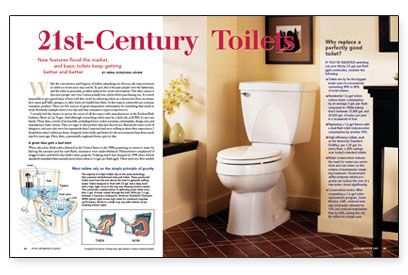21st-Century Toilets
New features flood the market, and basic toilets keep getting better and better.

Synopsis: A look at the latest toilets on the market and why they function much better than the low-flush toilets of just a few years ago. In addition to identifying well-performing basic toilets, the author looks at toilets for special needs, including combination bidet/toilets, toddler water closets, toilets for the severely overweight, and water-conserving dual-flush toilets. The article also includes information on water conservation.
While the convenience and hygiene of indoor plumbing are obvious, the improvements in toilets in recent years may not be. In part, this is because people view the bathroom, and the toilet in particular, as taboo subjects for social conversation. The other reason is that most people can’t test, I mean actually test, toilets before purchasing one. It’s nearly impossible to get a good sense of how well they work by admiring toilets on a showroom floor, no matter how many golf balls, sponges, or other items are loaded into them. In this respect, commodes are a unique consumer product: there are few sources of good comparative information for something that needs to work flawlessly multiple times every day and that consumers expect to last forever.
I recently had the chance to survey the wares of all the major toilet manufacturers at the Kitchen/Bath Industry Show in Las Vegas. And although researching toilets may be a dark job, at K/BIS it’s sure not lonely. These days, crowds of serious folk, including former rocket scientists, contemplate, design, test, and manufacture water closets. They are eager to discuss their data and discoveries. Beyond the inner circle of designers, end users also were less squeamish than I expected and were willing to share their experiences. I found that today’s toilets are better designed, better built, and better for the environment than those made just five years ago. Here, then, a perennially neglected fixture gets its due.
A great idea gets a bad start
When ultra-low-flush toilets debuted in the United States in the 1980s promising to conserve water by halving the amount used for each flush, consumers were underwhelmed. Homeowners complained of clogged toilets and bowls that didn’t clean properly. Nothing much had changed by 1994 when federal standards mandated that manufacturers limit toilets to 1.6 gal. per flush (gpf). These early low-flow models differed from their high-flow cousins in one respect only: the volume of water used per flush. The unhappy results sullied the rollout of the entire 1.6-gpf effort. To shake the nasty reputation, low-flush toilets had to be reinvented from the ground up.
Improving an old design
The vast majority of today’s residential toilets rely on the same basic principles as indoor toilets of 125 years ago. A holding tank above the bowl stores water. Depressing the lever on a gravity-fed toilet raises a flapper at the bottom of the tank; gravity moves water from the tank to the bowl. The water enters the bowl forcefully through jets under the rim and/or through a siphon hole in the bottom of the bowl. The rushing water cleans the bowl sides and starts the contents of the bowl moving into the trap way. As the water level in the bowl rises, it crests the curve in the trap way and pours into the drain, initiating the siphonic action that pulls the bowl contents through the trap way into the drain.
For more photos and details, click the View PDF button below:
Fine Homebuilding Recommended Products
Fine Homebuilding receives a commission for items purchased through links on this site, including Amazon Associates and other affiliate advertising programs.

The New Carbon Architecture: Building to Cool the Climate

Not So Big House

All New Bathroom Ideas that Work


























